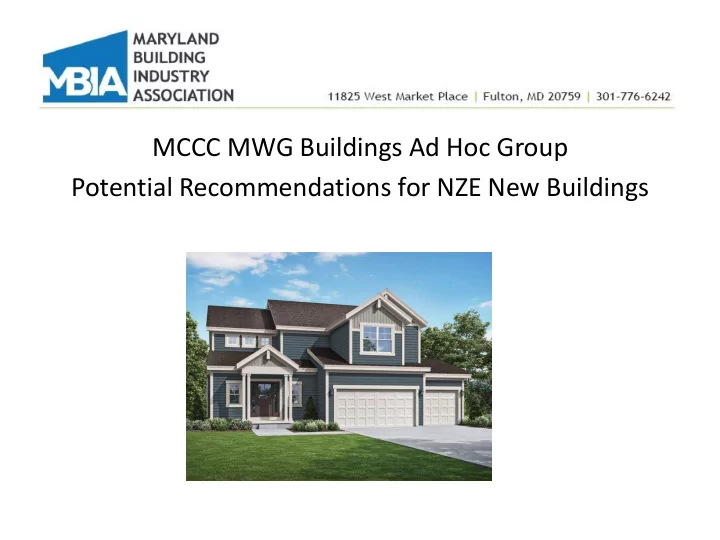

MCCC MWG Buildings Ad Hoc Group Potential Recommendations for NZE New Buildings
Potential Standards for New Homes Which path? not necessary, marketplace can decide • As Lori stated, “New homes are 38% to 45% more efficient. At least 30% market share for above code homes in 2018 & 2019 2018 RESNET, HERS • Builders and Developers will find appropriate solutions when they are empowered with a definite and consistent program. Energy Star, DOE ZER,NGBS and LEED programs could flourish with strong State support and messaging. Reynolds Landing Birmingham AL, Gas turbine, Resilient, battery storage, Community PV
Potential Standards , Cont’d Tivoly Eco-Village, opening 2021
Potential Standards, cont’d. • Integrating community solar, low-energy-consuming buildings and NGBS-certified land use standards require support from County Land Use departments. • Lot layout and structure aligned to South, Carolina singlewide, Charlestown SC. • Community solar utilizing open-space with rooftops & parking structures require better lot design • Encourage ADU’s and density in development zones
Implementation Timeline • Depends on the State's willingness to develop consumer education messages that builders can use in their marketing to sell (“Good,” “Better,” & “Best”) energy performance options. (House Bill 680, 2018) • The State must support processes that change the appraisal process for valuing efficient homes relative to minimum code and require lenders to adjust loan qualifications for annual energy savings and tax incentives paid to the buyer.
Implement, cont’d • Local Baltimore Builder constructs DOE ZER HERS Zero home, 2020, Sustainable Design Award winner • Invested in pre-appraisal of Modeled Energy Design • Educated loan-originators of energy savings and buyer tax credits Jenkins Builders 3915 Putty Hill Ave., Nottingham MD
Exemptions • Permit builders to integrate gas into the building when there is an easy solution for switching to electric. • Allow developers to supply gas at a single point when they forgo community gas service. – Example: Reynolds Landing • Keep the trees: shaded building lots connect to Community Solar installations, assign energy production to a specific lots as an energy funding source and repayment obligation.
Potential Incentives • Federal tax credits – 45L federal tax credit for builders of high-performance homes that exceed minimum Energy Star increases HERS/ERI by 10% to 15% – HB 2 creates a 10-year sustained credit of $2,500 per dwelling • State and Local tax credits – Baltimore, Anne Arundel, & Howard Counties 30% to 100% short-term property tax reduction for homeowners buying low HERS and Green Certified housing
Potential Incentives, cont’d. • Encourage innovation between industry and government: – Loan originators - Consider energy savings using PITI + Utility – Adjust PITI for County tax credits for low HERS & Green homes – Integrate appraisals for HERS & Green homes – Enable land use codes to increase density, adjust Min. house size, and utilize zero lot line positioning – Fast-track NZE-designated communities
Barriers to Adoption • Consumer preference for gas - perceived as less expensive, more comfortable, • Secondary mortgage market prevents adjusted LTV’s for low energy using homes • Lack of appraiser education re. energy efficiency and Green advantages • Lengthy investment window for builders • Steep learning curve to reach innovative solutions • Building partners resist re-tooling without a significant investment that is supported with long-term funding sources.
Contact • Lori Graf, MBIA CEO – lgraf@marylandbuilders.org – (301) 776-6205 • Thomas Marston, Greengurus LLC – thommgreengurus@gmail.com – (302) 383-3000
Recommend
More recommend